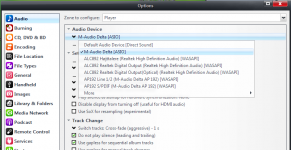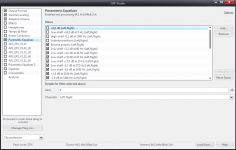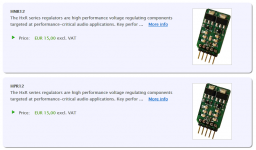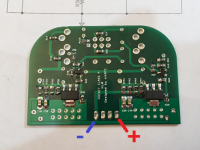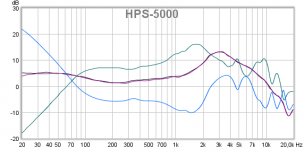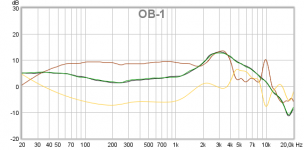I use Equalizer APO on my windows machine and that free program applies system wide EQ. It can accept EQ settings, so just enter the 25 filter settings Brett suggested and you should be good to go
Now I gotta learn how to figure out the filter numbers for my other headphones relative to HD600
Now I gotta learn how to figure out the filter numbers for my other headphones relative to HD600
I created similar corrective EQ curves for my old Grado SR80E and my current HD598, based on the measurements I found at InnerFidelity and Headphone.com...if anybody has those cans and is interested, just search up my threads on Head-Fi. I always thought the EQ settings sounded fantastic out of Logic Pro on my Mac (which I used to create them), but lousy out of my portable Rockboxed players, where I noticed significant smearing due to phase shift. Both EQs are supposedly minimum-phase, but the Logic engine is obviously superior to the RB implementation. If I had a PC, I'd definitely be running APO on it. You all have inspired me to give JRiver a whirl on my Mac. Thanks!
Byrtt,
Thank you so much for making this Easy.
I am going to buy a copy of Jriver (finally). Can't wait to hear this in balanced drive mode on OB-1's. If you say it's like sitting at sweet spot on couch in Assen listening to the Two Towers - this is indeed special treat awaiting for me.
Yes, this is very exciting and all new to me. Still not sure how to implement this, but quess I will have to start with installing JRiver. I am currently using MusicBee, which can import WinAmp DSP plugins - which might or might not work according to Wiki. Goodbye MusicBee.
Will soon get back with some little guide to have you started up, JRiver is very powerfull with a 64bit engine room in behind but okay maybe little technical to set up but its very flexible when one get used to it, haven't used feature myself but as example it has something called zones that also cover settings that will mean if one make different zones called example DT880 / HD650 / OB-1 / HT / STEREO one can fast change scenario between optimized correction settings for those different devices.
You need rechargeable Li-ions, here is what I use:
https://www.amazon.com/EBL-Self-Discharge-Lithium-ion-Rechargeable-Batteries/dp/B00EQ3U2AA
You can charge a set while listening to other set. Also, if you plan on using mostly for desktop use, I can show you how to make a desktop PSU so that regular 5.5mm 12v SMPS can power amp. I use DC step up to 18v (1.2MHz switcher) and CRCRC filter./
My use is not mobile but at desktop so that would be nice info when you find the time, regarding PSU there is some interesting info at this link (Simple Voltage Regulators Part 1: Noise - [English]) read page 1 to 4, that for power quality alkaline elements is on a par with two zener-filtered active supplies but rechargeable batteries are worse so will like some kind of PSU to get costs down and environmentally friendly.
I thought Litz wire is the best? That's what is in the current OB-1's and my DT880's. Although I see a lot of boutique headphone audio stores selling outrageously priced hand made cables using some sort of hand-twisted pair clear (pink looking copper) 3.5mm to 3.5mm (3inch long) cables for the cost of my amp! What is the world coming to?
$265:
https://www.aloaudio.com/shop/reference-8-mini-to-mini/
Think cables sound different and everybody has their preference : ) but not shure Litz wire is the best for relative low frq audio band but practical for its flexibility and also maybe they use it because it then gives same signature as some other famous brands.
For me head phones performance often sound bit synthetic or non realistic compared to real world sounds, chain-wise we very close to same quality source track as mastering engineer was, actually only a DAC / PCA / Head phones away from copy of original code so think cables is very audioable. If simple solid core cable will help remove the little bit synthetic veil i hear in setup with OB-1 is question but it had worked for HD 280 Pro and speaker setup. It can not be questioned sound is impressive and kind of narcotics in I'm onto third set of 9 volters for today but can it be improved for better realistic sound think is worth investigate.
Agree comment about that particular cable there cost is insane, its costs plus look and marketing is probably what drives people to use so much money for so little simple electrical function.
I use Equalizer APO on my windows machine and that free program applies system wide EQ. It can accept EQ settings, so just enter the 25 filter settings Brett suggested and you should be good to go
Now I gotta learn how to figure out the filter numbers for my other headphones relative to HD600
As help for less work creating HD600 correction find Harman target curve response attached below as txt file, if its complicated create HD600 correction i can share procedure how OB-1 correction was created but in general it was as talked about into post 915.
I created similar corrective EQ curves for my old Grado SR80E and my current HD598, based on the measurements I found at InnerFidelity and Headphone.com...if anybody has those cans and is interested, just search up my threads on Head-Fi. I always thought the EQ settings sounded fantastic out of Logic Pro on my Mac (which I used to create them), but lousy out of my portable Rockboxed players, where I noticed significant smearing due to phase shift. Both EQs are supposedly minimum-phase, but the Logic engine is obviously superior to the RB implementation. If I had a PC, I'd definitely be running APO on it. You all have inspired me to give JRiver a whirl on my Mac. Thanks!
Thanks sharing and agree from todays experience that correction for head phones indeed can sound fantastic, good luck on JRiver exercise.
Attachments
Last edited:
Byrtt,
I have used this with a 19v SMPS for an HP laptop as source and then regulate down to 17v - it works quite well. There is AC input but I found that has residual hum whereas SMPS did not.
Ultra-low Noise <40?V Adjustable Voltage Regulator Module, 1.25~20V, sku9511a | eBay
Then I just saw this one with 6uV rms at 15V and -125dB ripple rejection. Actually this is the best regulator I have seen. Very cool. But $49
Ultra Low Noise Positive Discrete Voltage Regulator | eBay
I have used this with a 19v SMPS for an HP laptop as source and then regulate down to 17v - it works quite well. There is AC input but I found that has residual hum whereas SMPS did not.
Ultra-low Noise <40?V Adjustable Voltage Regulator Module, 1.25~20V, sku9511a | eBay
Then I just saw this one with 6uV rms at 15V and -125dB ripple rejection. Actually this is the best regulator I have seen. Very cool. But $49
Ultra Low Noise Positive Discrete Voltage Regulator | eBay
twocents and xrk971,
Am not perfect and remember all steps 100% into JRiver first time setup but wil try best i can so sound stream quality is good.
1. After install and startup look down in lower left corner when it tries get ones focus to set up library for multimedia files, think one can pick auto or stop process and manual set it up later which is in "File/Library/Import" then follow its guided menus. Its also advanced player for visual multimedia material so many features and settings is not only about audio. If you want it take over as player for all possible multi media stuff use windows build in feature to setup which program is responsible for opening which file extensions.
2. To setup soundcard go into "Tools/Options/Audio" and set it up for WASAPI or ASIO to get bit perfect playback, first picture below is example for mine setup to use ASIO, think start use WASAPI which is Microsoft feature to bit perfect and works flawless where ASIO can be bit more tricky probably because its non Windows driver and complicated buffer setting control panel from soundcard manufacture can often be necessary to trim right before sound stream flow perfect, drawback using WASAPI or ASIO can be or not that it takes exclusive control of sound card so as long JRiver is playing no sound from other programs will pass.
3. DSP engine is called "DSP Studio" and a fast way to call it without going through "Tools/Options" menus is place mouse over the three arrows at right side up at top and push button "DSP Studio". Second picture below show mine and understand containers over at left works so that sound stream comes in at top and goes down thru actual containers you tick on, and if for example their routing order is wrong simply drag containers with mouse up or downwards to get right routing, if done on the fly when music is playing expect some digital noise. Suggest have same containers as mine ticked on, Highlight "Output Format" and at right set it up so no sample rate converting is happening for sound cards supported modes, "Volume Leveling" have no settings but "Adaptive Volume" will also need highlighted and setup over at right suggest set it to "Peak Level Normalize", these two will ensure same volume leveling for all tracks but be aware it works not 100% before in bag ground JRiver has analyzed dynamic range and leveling for all media library. In "Parametric Equalizer" or "Parametric Equalizer 2" set those 25 filters from post 916 plus a "Reverse polarity" to correct inverting source follower SE topology.
Am not perfect and remember all steps 100% into JRiver first time setup but wil try best i can so sound stream quality is good.
1. After install and startup look down in lower left corner when it tries get ones focus to set up library for multimedia files, think one can pick auto or stop process and manual set it up later which is in "File/Library/Import" then follow its guided menus. Its also advanced player for visual multimedia material so many features and settings is not only about audio. If you want it take over as player for all possible multi media stuff use windows build in feature to setup which program is responsible for opening which file extensions.
2. To setup soundcard go into "Tools/Options/Audio" and set it up for WASAPI or ASIO to get bit perfect playback, first picture below is example for mine setup to use ASIO, think start use WASAPI which is Microsoft feature to bit perfect and works flawless where ASIO can be bit more tricky probably because its non Windows driver and complicated buffer setting control panel from soundcard manufacture can often be necessary to trim right before sound stream flow perfect, drawback using WASAPI or ASIO can be or not that it takes exclusive control of sound card so as long JRiver is playing no sound from other programs will pass.
3. DSP engine is called "DSP Studio" and a fast way to call it without going through "Tools/Options" menus is place mouse over the three arrows at right side up at top and push button "DSP Studio". Second picture below show mine and understand containers over at left works so that sound stream comes in at top and goes down thru actual containers you tick on, and if for example their routing order is wrong simply drag containers with mouse up or downwards to get right routing, if done on the fly when music is playing expect some digital noise. Suggest have same containers as mine ticked on, Highlight "Output Format" and at right set it up so no sample rate converting is happening for sound cards supported modes, "Volume Leveling" have no settings but "Adaptive Volume" will also need highlighted and setup over at right suggest set it to "Peak Level Normalize", these two will ensure same volume leveling for all tracks but be aware it works not 100% before in bag ground JRiver has analyzed dynamic range and leveling for all media library. In "Parametric Equalizer" or "Parametric Equalizer 2" set those 25 filters from post 916 plus a "Reverse polarity" to correct inverting source follower SE topology.
Attachments
I use Equalizer APO on my windows machine and that free program applies system wide EQ. It can accept EQ settings, so just enter the 25 filter settings Brett suggested and you should be good to go
Ok, I got Equalizer APO (32 bit version) installed on my Windows 7 PC as a test. I'm busy figuring out how to setup the filters in a txt file - looks easy. Do you have to setup a "reset" txt file also, to switch off all the filters? How do you normalize or reset your EQ again? Need to know before I start messing up the EQ. Thanks.
Ok, I got Equalizer APO (32 bit version) installed on my Windows 7 PC as a test. I'm busy figuring out how to setup the filters in a txt file - looks easy. Do you have to setup a "reset" txt file also, to switch off all the filters? How do you normalize or reset your EQ again? Need to know before I start messing up the EQ. Thanks.
I am not using text file.
the graphical interface is very intuitive.
https://a.fsdn.com/con/app/proj/equalizerapo/screenshots/Screenshot3_2.png/1
you can try the simple graphical EQ first, just to test the water out, try to match as closely the values Brett provided as you can and see if you like what you are hearing (there's an option to choose from 15-band, 31-band and variable band, go with the variable band option and you can choose your own frequency to modify)
to reset, or disable, there's a "power button" next to graphical EQ panel, click on it and it's turned off, it works instantly, you dont need to restart program, or restart computer.
when you feel more comfortable then you can disable graphical EQ and right click on an empty part of the program and add "parametric filter" each, one by one, and for each PEQ (parametric EQ) filter you added, it matches exactly one line from Brett's values (there's frequency, boost, and Q means how wide of neighbor frequencies you want to affect)
note: you may want to read up on PEQ to understand what each line from Brett's list mean (besides the frequency and boost db), for example LS = low shelf, etc
Last edited:
Has anyone had luck sourcing the tiny metal crimp sockets from Mouser? I lost track of the four I was saving for build #2, and had to steal the battery wires from build #1 to get the second one up and running. Now I am about to place a Mouser cap order and I'd rather not have pay shipping for an additional box from Digikey.
.....Can this be done on an Andriod device? I stream mostly from my cell phone using a USB Sabre ES9023 DAC.
Would suppose it can be done and there is freeware out there to do it, myself is on Window so is not good at Linux stuff but over time surfing www stumbled over tons of Linux software that is supposed to do advanced EQ.
You could try out JRiver on Windows first to find out if you agree OB-1 will shine when corrected, say this because JRiver will work full featured for 30 days before it need license which by the way is allowed to run on two computers, also know your USB Sabre ES9023 DAC works setup to WASAPI in JRiver because have had such interface from HIFImeDIY setup to run for a long time in past. Then if you find EQ corrected OB-1 worth it invest the time and study it needs to setup EQ on Android device or go JRiver way.
Alternative its also possible setup a computer with JRiver just to do the EQ job in it can listen on input too, but it will cost one exstra set of DAC/ADC conversion going from ES9023 output to input in EQ computer.
Yes its possible although using same device for I/O can sometimes give bit extra work with settings to get it working where using two different devices is said be easier to set up. When you say real time i say that is possible but then remember only set IIR filters or FIR filters that don't touch phase domain inside JRiver because if one set FIR filters that also correct phase domain there will be a delay at output relative to input which is not a problem listening audio only but if used for movies its a problem for lips sync.
Have dedicated JRiver computer myself for speaker correction that listen at soundcards input and output to multiple outputs controlling active multi way speaker, because its listening at input and not used as player also is because to control VHF area for tweeters roll off one have to lock soundcard sample rate to be high say 96kHz or 192kHz else a PEQ say at 36kHz wont work, and if one play 44,1kHz tracks inside a locked 192kHz soundcard it sounds not right because the right 44,1kHz DAC reconstruction filter is missing then, and therefor it is listening on input and another computer is used as player and set up to play tracks native sample rate, it cost that extra DAC/ADC chain but think is worth it to control tweeter roll off.
By the way think of some temporary PSU for PCA in have some used 12000uF capacitors laying around, if cascaded say (4x) RCRCRCRC and then a LM317 regulator, what voltage should it be setup to 16V ? / 18V ?
Have dedicated JRiver computer myself for speaker correction that listen at soundcards input and output to multiple outputs controlling active multi way speaker, because its listening at input and not used as player also is because to control VHF area for tweeters roll off one have to lock soundcard sample rate to be high say 96kHz or 192kHz else a PEQ say at 36kHz wont work, and if one play 44,1kHz tracks inside a locked 192kHz soundcard it sounds not right because the right 44,1kHz DAC reconstruction filter is missing then, and therefor it is listening on input and another computer is used as player and set up to play tracks native sample rate, it cost that extra DAC/ADC chain but think is worth it to control tweeter roll off.
By the way think of some temporary PSU for PCA in have some used 12000uF capacitors laying around, if cascaded say (4x) RCRCRCRC and then a LM317 regulator, what voltage should it be setup to 16V ? / 18V ?
what was the go for using LiIon batteries for the amp? My li-ion batteries just arrived, but I think I remember having to click it on and off till the LED stays strongly lit. No matter how long I click it on and off it won't stay strongly lit? (it will increase though). What did I miss?
By the way think of some temporary PSU for PCA in have some used 12000uF capacitors laying around, if cascaded say (4x) RCRCRCRC and then a LM317 regulator, what voltage should it be setup to 16V ? / 18V ?
That should be fine and use maybe 4.7R for the R filter. 18v is the highest I would go but there may be some heat produced. Try 16.5v first and if you can live with it, better for longevity. But 18v will sound better as it makes higher bias which is good for lower impedance headphones.
That should be fine and use maybe 4.7R for the R filter. 18v is the highest I would go but there may be some heat produced. Try 16.5v first and if you can live with it, better for longevity. But 18v will sound better as it makes higher bias which is good for lower impedance headphones.
Thanks think will try it next weekend then and ha ha if 18V will sound better would probably be tempted because headphones is in lower regions being 32/54/64 ohms, tell if heat and longevity is a problem then i add some heatsink, in its temporary rough solution its no problem looks wouldn't be nice and rather like to go for SQ : )
Is it alright connect regulated PSU as below if at same 2x loose flying plugs for 9V elements is temporary isolated, ask because being lazy then can hack it without dismantle anything in PCA.
Attachments
Traced also average response of dirty cheap Behringer HPS-5000 and created correction to hit Harman curve and must say in corrected stage OB-1 verse HPS-5000 now start sound very much exactly the same, for long listening sessions HPS-5000 wins because they don't clamp so hard against head and also weight much less but in they cheap don't have any nice look or feel of nice build quality.
HPS-5000 correction below, black is Harman target response curve, green is traced average of HPS-5000 raw curves measured over innerfidelity website, blue is correction curve which takes 35x EQ filters or one convolution 32bit wav-file, and purple is green times blue showing fair close coherence to black target.
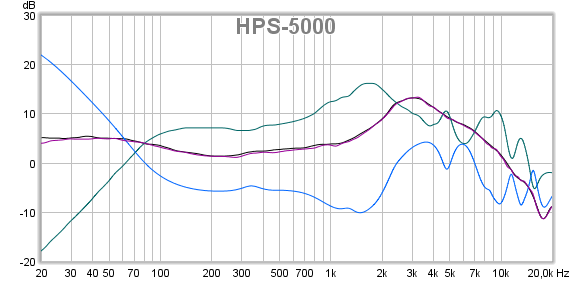
OB-1 correction below, black is Harman target response curve, brown is traced average of OB-1 raw curves measured over innerfidelity website, orange is correction curve which takes 25x EQ filters or one convolution 32bit wav-file, and green is brown times orange showing fair close coherence to black target.
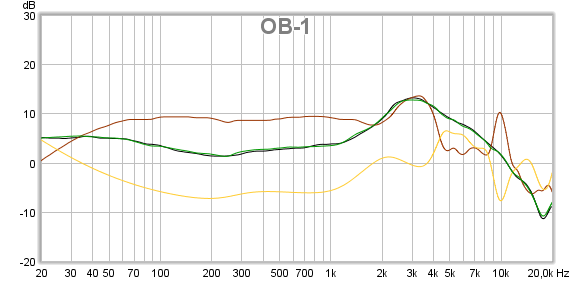
Can share numbers for these HPS-5000 filters too so if any is interested give a note.
HPS-5000 correction below, black is Harman target response curve, green is traced average of HPS-5000 raw curves measured over innerfidelity website, blue is correction curve which takes 35x EQ filters or one convolution 32bit wav-file, and purple is green times blue showing fair close coherence to black target.
OB-1 correction below, black is Harman target response curve, brown is traced average of OB-1 raw curves measured over innerfidelity website, orange is correction curve which takes 25x EQ filters or one convolution 32bit wav-file, and green is brown times orange showing fair close coherence to black target.
Can share numbers for these HPS-5000 filters too so if any is interested give a note.
Attachments
- Home
- Group Buys
- xrk971 Pocket Class A Headamp GB
